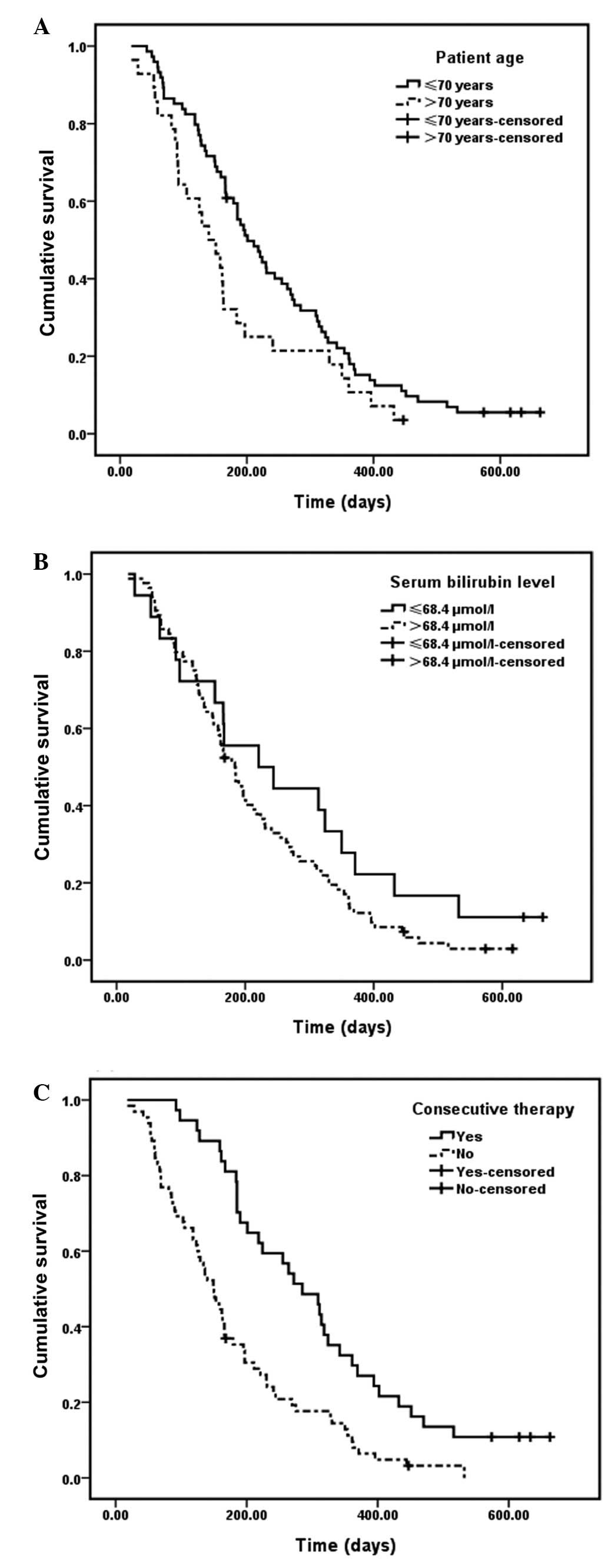|
1
|
Berberat PO, Künzli BM, Gulbinas A, et al:
An audit of outcomes of a series of periampullary carcinomas. Eur J
Surg Oncol. 35:187–191. 2009. View Article : Google Scholar : PubMed/NCBI
|
|
2
|
Henson DE, Schwartz AM, Nsouli H and
Albores-Saavedra J: Carcinomas of the pancreas, gallbladder,
extrahepatic bile ducts, and ampulla of vater share a field for
carcinogenesis: a population-based study. Arch Pathol Lab Med.
133:67–71. 2009.
|
|
3
|
Hatzaras I, George N, Muscarella P, Melvin
WS, Ellison EC and Bloomston M: Predictors of survival in
periampullary cancers following pancreaticoduodenectomy. Ann Surg
Oncol. 17:991–997. 2010. View Article : Google Scholar : PubMed/NCBI
|
|
4
|
Thornton RH, Ulrich R, Hsu M, et al:
Outcomes of patients undergoing percutaneous biliary drainage to
reduce bilirubin for administration of chemotherapy. J Vasc Interv
Radiol. 23:89–95. 2012. View Article : Google Scholar
|
|
5
|
Iacono C, Ruzzenente A, Campagnaro T,
Bortolasi L, Valdegamberi A and Guglielmi A: Role of preoperative
biliary drainage in jaundiced patients who are candidates for
pancreatoduodenectomy or hepatic resection: highlights and
drawbacks. Ann Surg. 257:191–204. 2013. View Article : Google Scholar
|
|
6
|
Brown KT and Covey AM: Management of
malignant biliary obstruction. Tech Vasc Interv Radiol. 11:43–50.
2008. View Article : Google Scholar : PubMed/NCBI
|
|
7
|
Tsuyuguchi T, Takada T, Miyazaki M, et al:
Stenting and interventional radiology for obstructive jaundice in
patients with unresectable biliary tract carcinomas. J
Hepatobiliary Pancreat Surg. 15:69–73. 2008. View Article : Google Scholar
|
|
8
|
Robson PC, Heffernan N, Gonen M, et al:
Prospective study of outcomes after percutaneous biliary drainage
for malignant biliary obstruction. Annal Surg Oncol. 17:2303–2311.
2010. View Article : Google Scholar : PubMed/NCBI
|
|
9
|
Nagino M, Takada T, Miyazaki M, et al:
Preoperative biliary drainage for biliary tract and ampullary
carcinomas. J Hepatobiliary Pancreat Surg. 15:25–30. 2008.
View Article : Google Scholar : PubMed/NCBI
|
|
10
|
Morris-Stiff G, Tamijmarane A, Tan YM, et
al: Pre-operative stenting is associated with a higher prevalence
of post-operative complications following pancreatoduodenectomy.
Int J Surg. 9:145–149. 2011. View Article : Google Scholar
|
|
11
|
Chu KM, Law S, Branicki FJ and Wong J:
Extrahepatic biliary obstruction by metastatic gastric carcinoma. J
Clin Gastroenterol. 27:63–66. 1998. View Article : Google Scholar : PubMed/NCBI
|
|
12
|
Makino T, Fujitani K, Tsujinaka T, et al:
Role of percutaneous transhepatic biliary drainage in patients with
obstructive jaundice caused by local recurrence of gastric cancer.
Hepatogastroenterology. 55:54–57. 2008.
|
|
13
|
Migita K, Watanabe A, Yoshioka T,
Kinoshita S and Ohyama T: Clinical outcome of malignant biliary
obstruction caused by metastatic gastric cancer. World J Surg.
33:2396–2402. 2009. View Article : Google Scholar : PubMed/NCBI
|
|
14
|
Schmassmann A, von Gunten E, Knuchel J,
Scheurer U, Fehr HF and Halter F: Wallstents versus plastic stents
in malignant biliary obstruction: effects of stent patency of the
first and second stent on patient compliance and survival. Am J
Gastroenterol. 91:654–659. 1996.
|
|
15
|
Sacks D, McClenny TE, Cardella JF and
Lewis CA: Society of Interventional Radiology clinical practice
guidelines. J Vasc Interv Radiol. 14:S199–S202. 2003. View Article : Google Scholar : PubMed/NCBI
|
|
16
|
Saad WEA, Wallace MJ, Wojak JC, Kundu S
and Cardella JF: Quality improvement guidelines for percutaneous
transhepatic cholangiography, biliary drainage, and percutaneous
cholecystostomy. J Vasc Interv Radiol. 21:789–795. 2010. View Article : Google Scholar
|
|
17
|
van Delden OM and Laméris JS: Percutaneous
drainage and stenting for palliation of malignant bile duct
obstruction. Eur Radiol. 18:448–456. 2008.PubMed/NCBI
|
|
18
|
Inal M, Akgul E, Aksungur E, Demiryurek H
and Yagmur O: Percutaneous self-expandable uncovered metallic
stents in malignant biliary obstruction. Complications, follow-up
and reintervention in 154 patients. Acta Radiol. 44:139–146. 2003.
View Article : Google Scholar
|
|
19
|
Indar AA, Lobo DN, Gilliam AD, et al:
Percutaneous biliary metal wall stenting in malignant obstructive
jaundice. Eur J Gastroenterol Hepatol. 15:915–919. 2003. View Article : Google Scholar : PubMed/NCBI
|
|
20
|
Tapping CR, Byass OR and Cast JE:
Percutaneous transhepatic biliary drainage (PTBD) with or without
stenting-complications, re-stent rate and a new risk stratification
score. Eur Radiol. 21:1948–1955. 2011. View Article : Google Scholar
|
|
21
|
Beddy P and Ryan JM: Antibiotic
prophylaxis in interventional radiology - anything new? Tech Vasc
Interv Radiol. 9:69–76. 2006. View Article : Google Scholar : PubMed/NCBI
|
|
22
|
Clark CD, Picus D and Dunagan WC:
Bloodstream infections after interventional procedures in the
biliary tract. Radiology. 191:495–499. 1994. View Article : Google Scholar : PubMed/NCBI
|
|
23
|
Brountzos EN, Ptochis N, Panagiotou I,
Malagari K, Tzavara C and Kelekis D: A survival analysis of
patients with malignant biliary strictures treated by percutaneous
metallic stenting. Cardiovasc Intervent Radiol. 30:66–73. 2007.
View Article : Google Scholar : PubMed/NCBI
|
|
24
|
Gwon DI, Ko GY, Sung KB, et al: Clinical
outcomes after percutaneous biliary interventions in patients with
malignant biliary obstruction caused by metastatic gastric cancer.
Acta Radiol. 53:422–429. 2012. View Article : Google Scholar
|
|
25
|
Weston BR, Ross WA, Wolff RA, et al: Rate
of bilirubin regression after stenting in malignant biliary
obstruction for the initiation of chemotherapy: how soon should we
repeat endoscopic retrograde cholangiopancreatography? Cancer.
112:2417–2423. 2008. View Article : Google Scholar
|
|
26
|
van der Gaag NA, Rauws EAJ, van Eijck CH,
et al: Preoperative biliary drainage for cancer of the head of the
pancreas. New Engl J Med. 362:129–137. 2010.
|
|
27
|
Singh A and Lee JH: Self-expanding metal
stents for preoperative biliary drainage in patients receiving
neoadjuvant therapy for pancreatic cancer. J Gastrointest Oncol.
3:304–305. 2012.
|
|
28
|
Farges O, Regimbeau JM, Fuks D, et al:
Multicentre European study of preoperative biliary drainage for
hilar cholangiocarcinoma. Br J Surg. 100:274–283. 2013. View Article : Google Scholar : PubMed/NCBI
|















